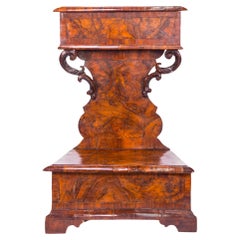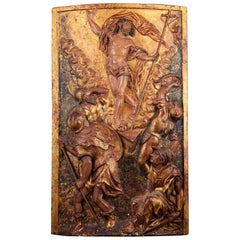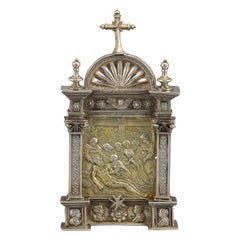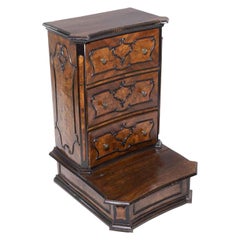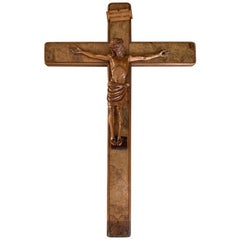Burl Religious Items
to
2
2
2
1
1
1
3,210
949
834
361
260
2
1
1
1
2
2
2
Material: Burl
Rare 19th Century Folding Pew, Altar, Desk from Regency Period, England or U.S.
Located in Lomita, CA
Form and function make this piece of furniture unique. If a piece of furniture could be clever, this desk, bench, altar, pew, would go to the head of the Sunday School class. It is v...
Category
Late 19th Century English Regency Antique Burl Religious Items
Materials
Burl
$1,127 Sale Price
40% Off
16th Century Prie-Dieu 'Praying Kneeler' Made of Walnut and Burl
Located in North Miami, FL
16th Century Italian Prie-dieu (Praying Kneeler) made of Italian walnut and burl wood.
Category
16th Century Italian Renaissance Antique Burl Religious Items
Materials
Wood, Walnut, Burl
$4,400 Sale Price
20% Off
Related Items
“Ressurrection”, Polychromed Wood, Spanish School, 16th Century
Located in Madrid, ES
The relief was probably a door of the Sagrario. The piece follows a customary decoration in the tabernacles of the Renaissance and the Baroque. Compare, for example, with the sevente...
Category
16th Century Spanish Renaissance Antique Burl Religious Items
Materials
Other
Silver Pax O Portapaz, Spain, 16th Century
Located in Madrid, ES
Portapaz. Silver in its color and gilded. Century XVI.
Portapaz made of silver that has a handle (decorated with delicate plant motifs similar to those of the pilasters) and a female and a male bust at the bottom, as well as other architectural elements on the back, and, on the front, an architectural composition classicist basement (with busts flanking a flower and a cross), two pilasters (vegetal decoration and capital recalling the composite order) with entablature (flowers flanking an angel's head; moldings), and a semicircular arch finish with elements veined in relief under cross and flanked by two architectural motifs in the upper part. This composition frames and enhances a gilt silver relief where you can see the Lament or Cry over the Body of Christ, with the Virgin holding the head of Jesus, Saint John at her side, the Magdalene and other characters, a cross following the group and a landscape background with houses and plant elements. This architectural structure mentioned is similar to the one present in other 16th century portapaces, such as that of the Magdalena de Dos Hermanas parish (Hernando de Ballesteros el Mozo, around 1575); or that of the Galaroza parish (same author and date); or that of the portapaz of San Miguel de Jerez de los Caballeros (in some details); etc. As for the relief, it is possible to clearly see a strong Italian influence, and the similarity between it and important pieces such as the Portapaz known as “de Cisneros by Juan de Burgos (1493-1497; MuseoCatedralicio de Alcalá de Henares), as well as in paintings and reliefs. Also noteworthy are both the male and female busts in the lower area and the Maltese cross (or Saint John's) that appears in this area. This symbol was used since the 12th century as an insignia by the Knights Hospitallers of the Order of Saint John of Jerusalem, also known as the Order of Malta...
Category
16th Century Spanish Renaissance Antique Burl Religious Items
Materials
Silver
Rare 19th Century English Tunbridgeware Hair Pin or Slide
Located in Dallas, TX
PRESENTING an EXTREMELY UNIQUE and RARE 19C British Tunbridgeware Hair Pin/Bobbin or Slide.
This slide is unlike any of it’s kind we have seen before, it is a VERY RARE survivor.
From circa 1860 – 80 and made in Tunbridge Wells, England.
Made of walnut with gorgeous marquetry inlay on the entirety of the front with classic Tunbridgeware micro-mosaic all over the front. The rear is walnut.
The marquetry inlay appears to be various different woods, namely, maple, walnut and satinwood.
Would have been worn in a Lady’s hair bun with the micro-mosaic facing forward.
This would have belonged to a VERY ELEGANT LADY in the mid to late 19th Century.
Tunbridge ware is a form of decoratively inlaid woodwork, typically in the form of boxes, that is characteristic of Tonbridge and the spa town of Royal Tunbridge Wells in Kent in the 18th and 19th centuries. The decoration typically consists of a mosaic of many very small pieces of different coloured woods that form a pictorial vignette. Shaped rods and slivers of wood were first carefully glued together, then cut into many thin slices of identical pictorial veneer with a fine saw. Elaborately striped and feathered bandings for framing were pre-formed in a similar fashion.
There is a collection of Tunbridge ware in the Tunbridge Wells Museum and Art Gallery in Tunbridge Wells.
The famous makers of Tunbridge ware were in the Tunbridge Wells area of Kent; their most notable work was from circa 1830-1900.
Early makers of Tunbridge ware, in Tunbridge Wells in the mid-18th century, were the Burrows family, and Fenner and Co. In the 19th century, around 1830, James Burrows invented a technique of creating mosaics from wooden tesserae. Henry Hollamby, apprenticed to the Burrows family, set up on his own in 1842 and became an important manufacturer of Tunbridge ware, employing about 40 people.
Edmund Nye (1797–1863) and his father took over the Fenner company when William Fenner retired in 1840, after 30 years in partnership with him. Thomas Barton (1819–1903), previously apprenticed at the Wise factory, joined the Nyes in 1836, and worked as Nye’s designer; he took over the business in 1863 and continued there until his death.
In Tonbridge (near to Tunbridge Wells), George Wise (1703–1779) is known to have had a business in 1746. It continued with his son Thomas, and Thomas’s nephew George (1779–1869), who took over in 1806. In its early years the company made articles such as workboxes and tea caddies with prints of popular views; later items had pictures created from mosaics. Their workshop in Tonbridge, Wise’s Tunbridge Ware Manufactory, was next to the Big Bridge over the Medway; the building was demolished in 1886 to widen the approach to the bridge.
Tunbridge ware became popular with visitors to the spa town of Tunbridge Wells, who bought them as souvenirs and gifts. Articles included cribbage boards, paperweights, writing slopes, snuffboxes and glove boxes.
At the Great Exhibition of 1851, Tunbridge ware by Edmund Nye, Robert Russell and Henry Hollamby was shown; Edmund Nye received a commendation from the judges for his work. He exhibited a table depicting a mosaic of a ship at sea; 110,800 tesserae were used in making the picture.
The manufacturers of Tunbridge ware were cottage industries, and they were no more than nine in Tunbridge Wells and one in Tonbridge. The number declined in the 1880s; competent craftsmen were hard to find, and public tastes changed. After the death of Thomas Barton in 1903 the only surviving firm was Boyce, Brown and Kemp, which closed in 1927.
Marquetry was an old technique which was continued by Nye and Barton to create images such as birds or butterflies.
‘Green Oak’ as caused by the fungus Chlorociboria aeruginascens.
Stickware and half-square mosaic was invented by James Burrows in about 1830: a bunch of wooden sticks of different colours, each having triangular or diamond-shaped cross section, were tightly glued together; in the case of stickware, the resulting block was dried, then turned to form an article such as the base of a pincushion. For half-square mosaic, thin slices were taken from the composite block, and applied to a surface.
Tesselated mosaic, was a development by James Burrows of half-square mosaic; it was adopted by George Wise and Edmund Nye. Minute tesserae were used to form a wide variety of geometric and pictorial designs.
Many sorts of wood were used for the various colours; about 40 were in regular use. Only natural colors were used; green was provided by “green oak”, produced by the action of fungus on fallen oak. Designs for articles were often taken from designs of Berlin wool work.
Category
Late 19th Century English High Victorian Antique Burl Religious Items
Materials
Satinwood, Walnut
Fine 19th Century French Marquetry Prayer Kneeler (Prie-dieu)
Located in Austin, TX
French prayer kneeler (prie-dieu), 19thc., of carved marquetry case, having hinge top opening to velvet lined interior, over two drawers, all abo...
Category
19th Century French Antique Burl Religious Items
Materials
Wood
French 19th Century Brass Altar Candlestick Lamp and Shade
Located in Baton Rouge, LA
An antique brass altar candlestick from 19th century France, that has been converted into an electrified lamp. This gorgeous fixture i...
Category
19th Century French Gothic Antique Burl Religious Items
Materials
Brass
19th Century Lectern Louis-Philippe Period
Located in Beuzevillette, FR
This Louis-Philippe period table lectern in cherrywood resting on four turned legs, has three positions for three different reading angles.
France,
circa 1840.
Category
1840s French Louis Philippe Antique Burl Religious Items
Materials
Cherry
French 19th Century Needlepoint Prie Dieu
Located in Baton Rouge, LA
A French 19th century ebonized wood prie dieu upholstered in vibrant needlepoint. This dramatic prayer kneeler has a plush armrest rising from turned spindles forming an arched desig...
Category
19th Century French French Provincial Antique Burl Religious Items
Materials
Wool, Wood
19th Century Pet or Doll Bed
Located in East Hampton, NY
Exquisite pet/ doll bed in the Louis XXI style. all original silk brocade drapery and upholstery. and remnants of trims. mattress is stuffed horsehair. ostrich feather floret. (the h...
Category
Mid-19th Century Antique Burl Religious Items
Materials
Silk
Prie-Dieu or Oratory in Walnut and Burl Walnut, circa 1600
Located in Brussels, Brussels
Elegant oratory or prieu dieu (prayer Kneeler) in walnut and burr walnut from northern Italy circa 1600
Very beautiful Italian Renaissance furniture...
Category
16th Century Italian Renaissance Antique Burl Religious Items
Materials
Walnut
Early 19th Century Italian Altar
Located in Baton Rouge, LA
This early 19th century Italian altar is made of worn painted wood and worn fabric details. This is a highly decorative altar for the unknown Catholic saint...
Category
19th Century Italian Antique Burl Religious Items
Materials
Fabric, Wood, Paint
Antique Italian Carved Walnut Oratoire Prie Dieu Prayer Kneeler
Located in Carimate, Como
A good antique Italian Oratoire or Prie Dieu walnut cabinet crafted in beautiful wood, it stands on short legs over a knee resting platform base. The religious kneeler features two s...
Category
19th Century Italian Antique Burl Religious Items
Materials
Wood
$2,755
H 35.04 in W 28.75 in D 18.12 in
16th Century Italian Renaissance Carving of a Male Saint
Located in Stamford, CT
16th century Italian carved and polychromed figure of a male saint or prophet with a wonderful presence. Shown holding an open book in his right hand with flames at his feet, mid-16t...
Category
16th Century Italian Renaissance Antique Burl Religious Items
Materials
Wood
Previously Available Items
Italian 18th Century Lombard Kneeler Louis XV Faldstood with Three Drawers
Located in Milano, MI
From Italy, Lombardy a rare burl walnut prayer kneeler faldstool, an Italian Louis XV prayer bench with three drawers and ebonized jutting frames, dating back to the early 1700.
Fant...
Category
Early 18th Century Italian Louis XV Antique Burl Religious Items
Materials
Walnut, Burl
H 32.68 in W 21.66 in D 22.05 in
Fine Detailed Early 1900s Carved Burl Walnut Wood Wall Crucifix Corpus of Christ
Located in Lisse, NL
Well-crafted and sacred work of religious art.
This modest size and all hand-carved corpus of Christ is mounted on an oak cross and this fine example is in good condition. The cros...
Category
Early 20th Century German Art Deco Burl Religious Items
Materials
Wood, Oak, Burl
H 15 in W 9.75 in D 1.75 in
